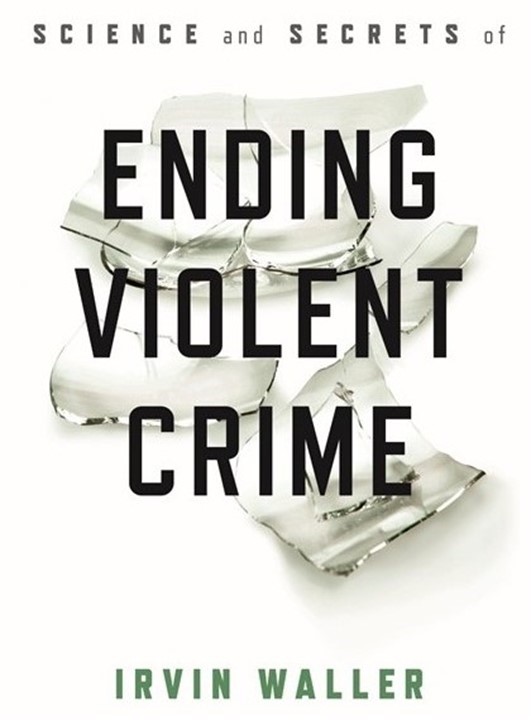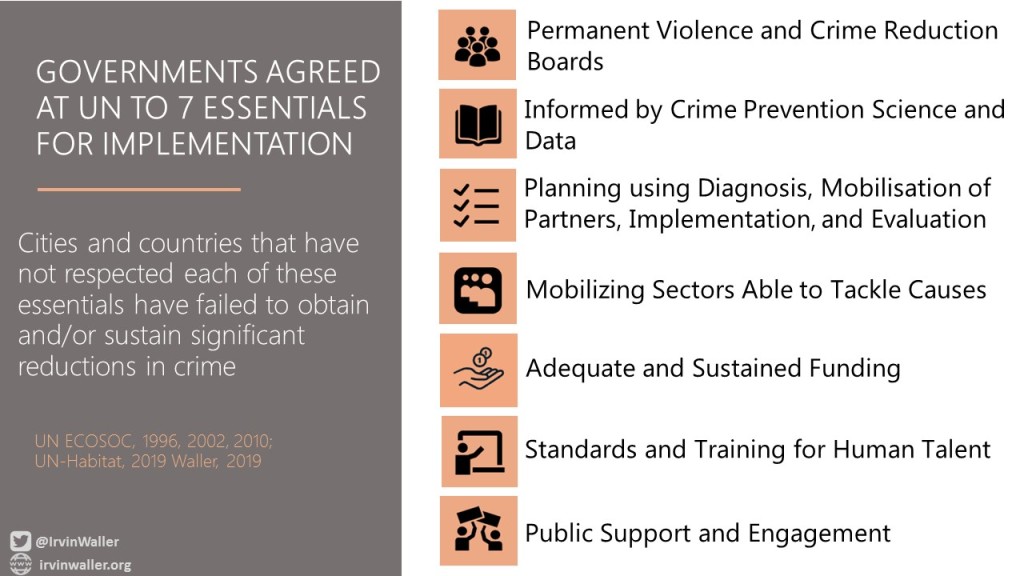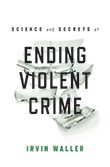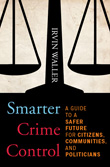The science of violence prevention is solid. If governments do not apply it, they should be challenged. Its public money. Its public safety. Its science. …John Carnochan in a tweet, 1 January 2018
Governments are sharing the science and successes of violence prevention on their websites. Governments are agreeing at the UN on how to apply the science. But Governments are not applying either locally. ¨It always seems impossible until it is done¨. One important way for governments to get it done and apply successfully the science is by getting smart and adopting a Prevention of Crime Act.
A Prevention of Crime Act is legislation that makes upstream crime prevention a key component in coping with crime and community safety. It must put scientifically proven successes to work, focus the work of the key sectors able to target the risk factors, ensure that the data and tools are available for planning and evaluation of results, promote training of the human talent, and promote awareness of the benefits of prevention.
It must establish a permanent crime prevention board and have adequate and sustained funding. It is not another criminal justice act concerned with punishment and correction, but an act about getting smart upstream on preventing crime in cities and communities that reduces the need for reactive policing and incarceration.
Science and Secrets of Ending Violent Crime
I have written a book on the Science and Secrets of Ending Violent Crime to put the solid violence prevention science to work. I want governments to stop the thousands of tragedies that are violent crime. I want governments, media and the public to get to know the science in language that the politicians and public can understand. I want everyone to be aware of how to make the smart investments that will stop violent crime, including how to invest, plan and evaluate results.
 I want us to realise that effective prevention is not only affordable and cost effective but you cannot significantly reduce the tragedies of homicides and rapes without it. I want to achieve reductions in mass incarceration by turning off the tap of offenders flowing into prisons by stopping offending. I want to provide the social movements determined to stop gun violence and violence against women with solutions that will make a difference that is transformative.
I want us to realise that effective prevention is not only affordable and cost effective but you cannot significantly reduce the tragedies of homicides and rapes without it. I want to achieve reductions in mass incarceration by turning off the tap of offenders flowing into prisons by stopping offending. I want to provide the social movements determined to stop gun violence and violence against women with solutions that will make a difference that is transformative.
Too Many Preventable Tragedies
Each year, just in the USA, thousands are dieing needlessly from gun violence and hundreds of thousands are getting shot. Hundreds of thousands of women are victims of rape. This is needless because we have the science on how to stop it. Though the rates of violence may differ, the problem is similar for modern democracies across the world.
Reducing Violent Crime – Getting Results for the Sustainable Development Goals
When governments committed in 2015 to make the transformations to achieve the Sustainable Development Goals, they agreed to achieve measurable and significant reductions in homicides and violence in SDG 16 as well as in sexual and intimate partner violence in SDG 5. These results were to be achieved by measuring indicators in the present and setting targets for their reduction by 2030. Transformations would be needed now such as smart investments in order to achieve the reductions by 2030. Though the SDG´s are still not well known, they set out a framework that is about outcomes and results rather than more of the same. They are about significantly fewer victims by using science not unreliable intuition.
Solid Science of Violence Prevention
We have 50 years of research based on clinical trials and scientific studies that show that the most effective and cost effective way to deal with crime is prevention. It is available from numerous websites supported by major government agencies such as the US Department of Justice , Public Safety Canada and the British College of Policing as well as the World Health Organization.
What is successful in preventing crime?
These confirm numerous programs that have successfully prevented crime, often by 50% or more, which are explained in Science and Secrets of Ending Violent Crime and in Smarter Crime Control. Examples include:
- In problem places, outreach to excluded youth (YIP); coaching vulnerable parents (Triple P); teaching to choose non-violence (Stop Now and Plan); providing job skills and jobs;
- In schools and universities, teaching healthy ways to avoid sexual assault (Fourth R); fostering bystander intervention; teaching peaceful conflict resolution;
- In health sector, social outreach in hospital emergency rooms; focus on recovery from PTSD for victims; collect data on context and segue;
- In police services, problem solving policing; control of knives and guns; supporting partners who solve social problems.
Prevention better than cure – Cost Benefit
The most cost effective and popular solutions to violence and mass incarceration lie outside criminal justice.
The Interamerican Development Bank and the Washington State Institute for Public Policy stress that the evidence shows that governments can get better results for less costs. These results are achievable, affordable and feasible for the equivalent of 10% of what the state spends on reacting to crime. There is room to improve the quality of spending through policies that are smarter – more preventive and less reactive, more focused and less broad-based, and more based on scientific evidence and less on intuition.
How do we get these successes implemented where they are needed.
The short answer is by respecting 7 essentials for successful implementation agreed, but not used by multiple governments on how to implement those successes. These include the importance of a crime prevention board, local diagnosis and planning, training those who will implement the solutions, and particularly sustained and adequate funding.
The Youth Violence Commission in the UK has concluded that “The root causes of youth violence include: childhood trauma, undiagnosed and untreated mental health issues, inadequate state provision and deficient parental support, poverty and social inequality.”
So their solutions include developing a national public health model, inspired by the sustained success of Glasgow, Scotland, which diagnosed the problems as the basis for implementing proven solutions encompassing proactive policing, youth outreach, parenting programs, and so on. Glasgow achieved a 50% reduction within 3 years of implementing the actions. The Mayor of London has recently adopted this model.
The tools for training the human talent are waiting to be used. The Prevention Institute in California has produced a podcast. The Province of Ontario in Canada has legislated a requirement for every municipality to develop a community safety and well being plan as the basis for the local diagnosis. The European Forum for Urban Security has produced its manual that is reflected in the trainings organized by the Canadian Municipal Network for Crime Prevention.
Conclusion
Think what a Prevention of Crime Act [youtube]https://www.youtube.com/watch?v=FgVorJJa2cM[/youtube] could do to end violence.



